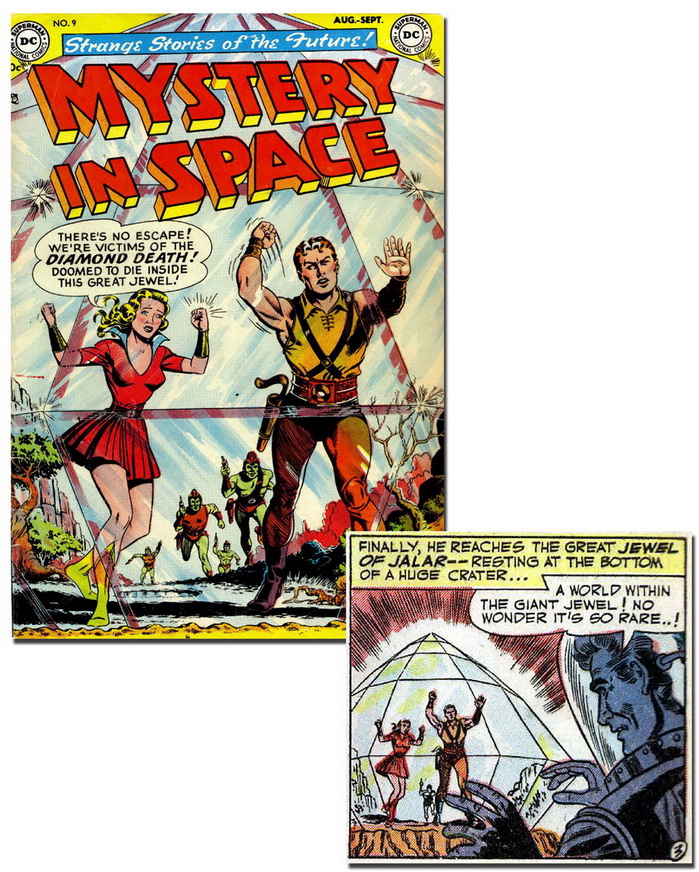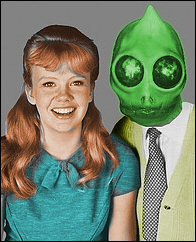In the Silver Age, comic book editors for DC often employed a practice of creating a cover for a book first, which was then used as a story suggestion for a writer. The house art director would often create a cover based on an editor suggestion for whatever the "hook" was for the title that would appear that month be it spaceship, bondage scene, monster or giant gorilla. The concept cover was a device used most often by DC editor Julie Schwartz in the Silver Age and led to some of the greatest cover disconnects of all time. DC even paid homage to the concept in the 2004 memorial DC Comics Presents series dedicated to Julie Schwartz. The cover disconnect (and cover artist bait-and-switch tactic) became a sore spot for fans in later years when the collector market grew to be a serious business in the 70's and 80's.
Back in the Silver Age the cover art was the primary lure used to hook a customer. While people did regularly look for DC titles the market was extremely fickle. Few readers if any sought out favorite authors and writers like they do for the current market. Rack space at the news stand was precious and every company had to do something to make sure their product was noticed. DC did this on one occasion by utilizing the 'Go-Go Checks' above the logos of their books, knowing customers could more easily identify a DC product among stacks of different periodicals.
Mystery In Space #9 is one of those covers that does not remotely resemble the story contained within the book. The cover features the climax of an exciting chase scene as the assumed protagonists of the story, hunted by evil aliens, are trapped against the walls of their snow-globe prison the Diamond of Death.
Looks like fun! But wait, the scene barely appears within the book and is shown in only one throw away panel and is not referenced at all.
 Mystery In Space #9 (Aug-Sept 1952)
Mystery In Space #9 (Aug-Sept 1952)The Diamond of Death scene appears nearly intact in a story that is much weaker than that suggested by the cover. In the story The Seven Wonders of Space, an Earthman is kidnapped and forced to recover items from archaeological sites for an alien museum. The opportunity to explore the presumably more interesting world within the diamond was missed by the creators. Pity, because the featured story was pretty dull and predictable.
The artist must have been compelled by necessity to include some small passing reference to the cover scene in the story because even in 1952 comic book fans were a pretty serious and strident bunch. Some of the letters from hard core fans in these older books were quite shrill, complaining that "Superman can't do this!" or "Space Ranger would never do that!" and such. Having completely faked out a buyer with the cover would have led to a flurry of angry letter writing to the DC offices. Today it's email and forum postings, which is easy and often ignored. Back then, letters took time to write and cost real money to send, so editors were polite enough and respected fans enough to actually have someone read the letters and not just filter them or delete them unseen from the server.
I really don't blame those ancient fans of comic books past. I often felt ripped-off by a cover that had a promise of story that turned out to be a disappointment or was deliberately misleading (curse you, 1980's Marvel and Frank Miller!). If the cover is not clearly a generic concept theme then don't tease me. It was even recognized in the Silver Age as a problem, hence the many covers by DC that proclaimed "Not An Imaginary Story!" on uncounted issues of Superman, Lois Lane and others that attempted to ensure that sales would not tank for that particular issue.


























No comments:
Post a Comment
Moderation enabled only because of trolling, racist, homophobic hate-mongers.
Note: Only a member of this blog may post a comment.